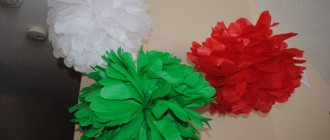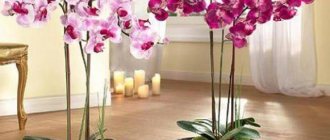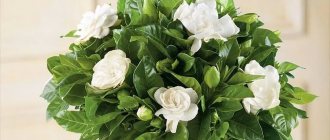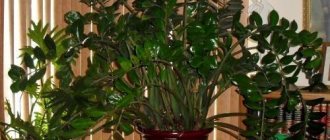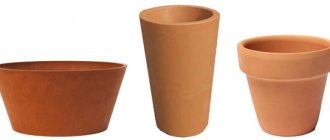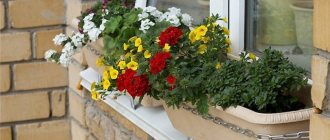We spend a lot of time in the kitchen, and I want this room to be decorated with flowers no worse than the rest. We have made a selection that includes decorative foliage and flowering indoor plants that feel great in the kitchen.
Due to the not very friendly climate, the kitchen as a permanent place of “residence” is not suitable for all indoor plants. However, there are quite a few flowers that will feel quite comfortable even here, purifying the air and having a positive effect on the health of their owners.
Features of floral curtains
It is interesting that plant motifs on textiles are harmoniously combined with absolutely the entire color palette.
Curtains with flowers look beautiful in combination with white, beige shades, rich, bright, variegated tones. You can safely use black, gray, brown tones, but it is important to take into account the purpose of the room itself, its functionality and size. When choosing curtains with flowers, it is important to take into account the following features and rules for using plant motifs:
- The most important thing to pay attention to when choosing curtains for a room is the size of the flowers. Curtains with large elements are suitable exclusively for large rooms. If the area is too limited in space, it is better to choose textiles with small flowers.
- It is imperative to take into account how harmoniously the hailstones look with the wall decoration. Wallpaper should match the color tone, but not the tone of the main background.
- It is advisable that the tone of the curtains match the upholstered furniture in the room, if it is used in the interior.
- When arranging a bedroom, it is recommended to choose textiles in calm shades, and the flowers should not be too large. Ideal options are desaturated blue, delicate blue, mint, beige, milky, dusty rose color. Curtains with flowers, especially if the elements are large, simultaneously perform several functions in the interior - they decorate the room, complement the overall interior, and attract the main attention, which is important if there are shortcomings in the design of the room.
- The interior looks very stylish, gentle, fresh and homely, in which the curtains and bedspread are made of the same floral fabric. A living room in this design will contribute to pleasant communication with family and friends. If the room is designed in the same color scheme, it is recommended to choose a darker background for the curtains so that they perform the main decorative function.
- Floral motifs on curtains are also great for the kitchen. It is recommended to choose an ornament depending on the style of the room. For a room designed in strict classics, choose window curtains in sand, brown or beige. If your kitchen is decorated in a modern high-tech style, the best choice would be cool shades - blue, mint, blue.
A room in which the walls are decorated with striped wallpaper and the windows are decorated with floral curtains looks very unusual, stylish and modern. With such a bold decision, it is advisable to give preference to curtains with large flowers.
House flowers that love heat and direct sunlight: names and photos
There are quite a lot of heat-loving indoor plants, and very diverse - large and small, flowering and non-flowering, succulents and deciduous... You can organize a whole garden on the windowsill and balcony, or you can just have a single flower that will please the eye.
cacti
The homeland of cacti is hot sunny deserts , so life in the bright sun is familiar to them. Dozens of subspecies are grown at home, varying in size, shape, characteristics of flowering or lack thereof, shape and pungency and other parameters - you can choose any of them that you like more than others.
Despite the fact that cacti are accustomed to heat and drought, these plants also thrive at moderate temperatures in the shade.
The advantage of cacti is their ability to store water and survive for a long time without watering, which makes them an ideal option for those who constantly forget to water their flowers.
Succulents for south-facing windows
The most popular succulents for home windowsills are aloe, kalanchoe, echeveria, crassula, crassula, agave and others. They are recognizable by their thick, succulent stems of various colors (not only green, but also gray, pink, purple, etc.) and the absence of leaves in the usual sense.
Any succulent resembles an elastic container with liquid, but its shape can be any, even the most bizarre. This allows you to create amazing compositions that are impossible when using deciduous and coniferous plants. During prolonged drought, succulents wither, but as soon as watering is returned, the plant itself “blooms” - this feature can be used in decoration.
Usually succulents do not bloom , but this is compensated by their unusual appearance in general.
Abutilone (domestic maple)
Abutilon is a genus of plants that includes different species (large and small, annual and perennial, with inflorescences of different colors and sizes). They are united by carved maple-like leaves and bright bell-shaped flowers with thin delicate petals and a darker center.
The color will depend on the variety - all shades of red, orange, yellow, white. There are also hybrid varieties with a wide variety of colors.
Despite its love of heat, abutilon is distinguished by lush green foliage, which makes it possible to green up stuffy balconies and rooms with its help.
Pelargonium (geranium)
Geranium is another type of indoor plant that tolerates constant sun (the more of it, the better) and high temperatures (over 20 degrees). It is distinguished by shiny dark green leaves forming a lush cap, and abundant flowering (under special conditions, even year-round). The flowers are bright and large, come in different colors - red, pink, crimson, yellow, burgundy and others, depending on the variety.
The frequency and splendor of geranium flowering can be controlled independently : with the support of stable conditions (warmth, light, regular fertilization and watering), it will bloom continuously, but if you put it into hibernation for a while, it will bloom many times more abundantly and brightly.
Balsam
Impatiens is a plant whose flowering part often grows larger than the green part. Because of the brightness of the flowers, it is sometimes called the sparkle. Impatiens of all varieties are unpretentious and feel equally good both in the sun and in the shade - this practically does not affect the characteristics of flowering, except for the duration (the more light, the longer it blooms).
The only thing that balsam does not like is excessive humidity and stagnation of water . There are no special requirements for other parameters (temperature, location, lighting and pruning). In flower shops you can find balsams of almost any color, including multi-colored ones.
Fuchsia
Fuchsia blooms from early spring to late autumn, and for this it is appreciated by lovers of bright, colorful plants.
It is quite whimsical (temperature 20–25 degrees, regular spraying, watering with fertilizer, pruning faded inflorescences and wilted stems), but it pleases the eye with large purple-crimson flowers of non-standard shape.
Fuchsia does well in the sun, but prefers diffused light rather than direct scorching rays.
Jasmine
At first glance, jasmine seems like an unusual choice for indoor growing, but it does have an indoor variety. This is a small bush with large snow-white flowers that exude a characteristic aroma. Jasmine can cause allergies!
It likes temperatures of about 20 degrees and bright light, so it is suitable for southern windows. Disadvantages include sensitivity to changing conditions - with a sharp change in temperature, air humidity level or feeding regime, jasmine immediately flies away.
Chlorophytum
Chlorophytum is a sort of long grass with a yellow core and dark green edges (shades may vary depending on the variety).
It belongs to the hanging species, so it often decorates walls. It is usually used for non-standard landscaping in offices, but many people also grow it at home. Loves bright light, but can get burned under constant scorching rays.
Campanula (Campanula equifolia)
Campanula is a classic pale purple bell, similar to the field one, but a little larger in the home version. It is a herbaceous plant that fills the entire area of the ground (therefore it loves wide pots). Blooms all summer.
It loves bright sunlight, but it is recommended to shade it from direct rays - otherwise the green part will fade and become discolored. The optimal temperature is 20–22 degrees.
Hoya (wax ivy)
Hoya is a tropical vine that is often used for landscaping and shading balconies or loggias in hot regions.
Hoya leaves are green-purple and large. The flowers are small and light, strongly fragrant at night.
Hoya loves warmth and sunlight, although its main growth time is night. Doesn't do well in tight spaces where there are no surfaces on which to crawl.
Rules for selecting fabrics
When choosing material for curtains, it is important to adhere to the following basic rules.
- The pattern on the canvas should be in harmony with the pattern on the walls of the room.
- Floral motifs in soft pastel colors fit organically into any interior.
- A large and bright print visually reduces the area of the room.
The decorative design of the windows must be selected to match the rest of the room’s design. Curtains with large and bright patterns overload the interior and cause psychological discomfort.
What indoor flowers will grow well in the kitchen?
In the presented selection of plants ideal for the kitchen, you will find both popular “kitchen” flowers and, we hope, you will discover something new in the world of indoor gardening.
Hoya fleshy
Wax ivy, or Hoya carnosa, is grown as a hanging or climbing plant. With proper care, this evergreen vine produces very unusual flowers that look as if they were sculpted from wax. They secrete droplets of nectar and emit a delicate aroma, which can come in very handy in the kitchen (if there are no allergy sufferers in the house).
Hoya carnosa, also known as "wax tree", purifies the air, and its leaves are used to treat furunculosis. But it is necessary to remember that hoya, like many indoor plants, is poisonous to humans and animals, so it is better to place the pot with the plant higher or place it in a hanging planter, and pull a fishing line for the branches along which they will curl.
Kalanchoe (or Kalanchoe)
This leafy succulent is known for its medicinal properties: it helps heal wounds, treat colds, reduce acne, etc. Kalanchoe daigremontiana has become popular as a houseplant. Kalanchoe purifies the air, disinfecting it, so it would not be superfluous to place a pot with this plant not only in the kitchen, but also in other rooms.
This medicinal plant does not require special care, prefers diffused light, moderate watering, is not afraid of drafts, and tolerates temperature changes in the room.
Saintpaulia
Numerous species of the genus Saintpaulia are known as Usambara violet (not to be confused with the genus Viola - this is a representative of a completely different family). Many note that Saintpaulia can have a positive effect on the energy in the room, improving the well-being of household members.
Saintpaulia loves moist air, shaded areas with diffused light, and moderate watering. But this plant does not tolerate drafts, so before ventilating the room, it is better to take the pot with Uzambara violet to another room.
Geranium
The beloved Geranium (Geranium), or cranebird, is a member of the Geranium family, but the plant that we used to call geranium actually belongs to another genus of the same family - Pelargonium.
Pelargonium is useful because its leaves contain a large amount of essential oils, which kill pathogens and have a beneficial effect on human health, having a calming effect. Geranium essential oil is widely used in perfumery and aromatherapy.
Phalaenopsis orchid
Despite the fact that plants of the Orchidaceae family have a reputation for being capricious and delicate flowers, representatives of the Phalaenopsis genus are considered “beginner orchids” due to their relative ease of care.
They feel good in the kitchen because they love high humidity and warmth, and there is plenty of them there. But the orchid needs to be protected from drafts. Phalaenopsis filters the air, destroying harmful substances such as xylene and toluene. The subtle aroma of orchid will improve your mood and mask unpleasant odors.
Eucharis (or eucharis)
The Amazon lily, or Eucharis, slightly reminiscent of a daffodil, will decorate any room, including the kitchen, if you “settle” this graceful plant on a western or eastern windowsill with diffused light.
Eucharis (Eucharis) is useful because it absorbs substances harmful to humans, purifying the air. The Amazon lily blooms with beautiful flowers with a delicate but refreshing and invigorating scent, so it is not recommended to place pots of this plant in the bedroom.
Chinese hibiscus
This representative of the genus Hibiscus is also called the Chinese rose (Hibiscus rosa-sinensis), despite the fact that hibiscus has no relationship with the real rose (rose hips): they belong to different families.
If you have a lot of indoor flowers growing in your kitchen, feel free to add a pot of Chinese rose to them, as it has a positive effect on the plants living in the neighborhood and also purifies the air. Moist air, moderate watering and well-lit space are what hibiscus needs.
Begonia
The effect of this plant on indoor air is similar to the work of a quartz lamp - it kills pathogenic microbes. Begonia, although poisonous to humans, nevertheless releases phytoncides that prevent the proliferation of microbes in the air.
Although the plant is heat-loving, you should not place it near radiators and heaters. Begonia loves bright, diffused light, but in summer the flower must be shaded, otherwise burns may appear on the leaves.
Cactus
Everyone knows how unpretentious in care and undemanding indoor plants of the Cactaceae family are. If the kitchen window faces south and there is still free space on the windowsill, don’t hesitate to “settle” your favorite view there.
Cacti protect against electromagnetic radiation and ionize the air. It is believed that the longer the needles of a cactus, the stronger its beneficial properties for humans. Remember that these plants do not like changes in location, so be responsible when choosing a permanent location for your “prickly pet.”
Pilea Cadieux
A member of the nettle family (Urticaceae), Pilea (Pilea) is quite popular in indoor floriculture. Plants of this genus amaze with their variety of shapes and colors. One of the most interesting species is Pilea cadierei.
Thanks to its exquisite shape, the Pilea will perfectly decorate any interior. Its beneficial effect on the composition of the air in the house is also known. To prevent the silver pattern on the leaves of this plant from fading, place the pot on a north or east window: this way the pilea will avoid being burned by direct sunlight, while still receiving enough light.
Chlorophytum
One of the most popular species is Chlorophytum comosum. This plant is considered a record holder for air purification. It removes harmful substances from the air in the room, including those formed due to smoking, the use of a gas stove, and aerosols, faster and more effectively than other indoor flowers.
Scientists have determined that within a day, chlorophytum can destroy 70-80% of pathogenic microflora in a room of 2 square meters, and it also humidifies the air. In addition, the plant is extremely easy to care for and grows well in low-light places.
Aspidistra
The tall aspidistra (Aspidistra elatior) is often called the “cast iron plant” because it can survive in the most unfavorable conditions. It does not require a lot of light: aspidistra grows equally well both on dimly lit northern windowsills and on sunny southern ones.
The plant withstands temperature changes, so when ventilating the room, the pot with it does not need to be rearranged. Aspidistra helps to humidify and purify the air.
Crassula
Most often, Crassula ovata (Crassula ovata) is grown as a houseplant. This flower is known to many by other names: money tree, tree of luck, jade (jadeite) plant. Crassula received these names because of the external resemblance of the leaves to jade and jadeite - stones that have been considered since ancient times as talismans bringing success, happiness, family well-being and longevity.
Crassula feels good on western and south-eastern windows. It filters and humidifies the air, which is why it is often kept in the kitchen.
Aloe vera
Aloe vera, or Aloe vera, is a beloved succulent with many beneficial and medicinal properties. In traditional and folk medicine, aloe is used to prevent and treat many diseases. This plant is also popular as a cosmetic additive.
Aloe neutralizes formaldehyde and benzene, absorbs carbon dioxide, having a healing effect on indoor air. This plant is undemanding in care and grows well both in bright sun (the light should be diffused) and in partial shade. Water aloe 1-2 times a week as the soil dries.
Sansevieria
In indoor gardening, the most popular type of this plant is Sansevieria trifasciata, popularly known as “pike tail”. Purifying the air from toxins that can be emitted by low-quality linoleum and other synthetic materials, sansevieria is indispensable in the kitchen (and it will not be superfluous in other rooms).
Sansevieria grows normally both in the shade and in direct sunlight, and tolerates drafts and excessively dry air. Thanks to its appearance, the “pike tail” fits perfectly into the interior of any style.
Philodendron
Plants of the Philodendron genus are also among the effective “air purifiers” because they are excellent at fighting harmful impurities. The following species are popular as indoor plants: F. golden-black (Ph. melanochrysum), F. bipinnate (Ph. bipinnatifidum), F. graceful (Ph. elegans), etc.
Philodendron is comfortable in partial shade or a bright place; it needs infrequent watering. Insufficient air humidity can be compensated by regularly wiping the leaves with a damp cloth and spraying with water (especially on hot days).
Zamioculcas
One of the plants known for its ease of care, although represented by a single species, has several names: Caladium zamiifolium, Zamioculcas loddigesii and Zamioculcas zamiifolia. Refers to plants that filter air.
This plant is native to tropical Africa, and therefore tolerates dry indoor air well. It is also patient with skipped watering, but do not overdo it - zamioculcas, like other indoor plants, needs moisture for normal development.
Ivy
Common ivy (Hedera helix) is famous for its healing properties. It helps in the fight against inflammation; in medicine it is used to treat burns and even tuberculosis. As a houseplant, ivy reduces the amount of carcinogens in the air, which means it belongs in the kitchen!
The plant is shade-tolerant and grows normally in dry soil, but in particularly hot weather it is recommended to spray ivy. Despite the many beneficial qualities, ivy leaves and berries are poisonous to humans.
Epipremnum
For indoor cultivation, a species of this genus is used, such as Epipremnum aureum, formerly known as Scindapsus aureus (now some species of the genus Scindapsus are classified in the genus Epipremnum, including this popular plant).
This evergreen vine can cleanse the air of harmful substances: carbon monoxide, benzene, formaldehyde. It is unpretentious in care, can grow in shaded places with dry air, but loves to be sprayed with soft, cool water (hard water will leave stains on the leaves of the plant).
Nolina
Due to the unusual shape of the trunk, this plant is popularly called “bottle tree”, “elephant’s foot” and “pony’s tail”, and its scientific name is Nolina, or Beaucarnea. The thickening in the lower part of the plant allows it to retain moisture for a long time, so if you forget to water the nolina a couple of times, it won’t even notice it, but this plant does not like drafts.
Nolina not only rids the indoor air of harmful gases, but also saturates it with oxygen, helping to reduce the risk of respiratory diseases.
By correctly placing an indoor flower in the kitchen, you will acquire a living air purifier and decorate the interior.
What should the drawing be like?
An equally important criterion when choosing curtains for your home is the pattern. For example, small ornaments are perfect for rooms with little free space. A small print can visually expand a room.
Large flowers are an ideal solution for spacious dining rooms and living rooms. Such curtains will highlight high ceilings and unusually wide windows.
Do you prefer Japanese style? The mystery of the East can be conveyed with the help of curtains with the image of sakura. This tree blooms at the beginning of the year, so your home will always have a spring mood, a spirit of romanticism and a desire for something ideal and pure. To enhance the effect, use organza. Sakura flowers should not be stuffed, but carefully embroidered with colored threads.
Today, there are a huge number of variations on the theme of “floral print in window decoration.” With such a variety, it is important to choose those curtains that will most advantageously and harmoniously fit into the interior of the room. By adhering to the above rules, you can always choose the ideal option for your home.
Selection of indoor plants for the interior (ideas, photos)
The popularity of various types of indoor decorative crops is determined by several criteria. Among them are unpretentiousness, easy care, endurance, rapid adaptation to new conditions, and abundant flowering. The need for lighting must be taken into account in order to ensure the high-quality development of flowering crops, which are grouped according to this indicator into two broad groups.
Photophilous
The vast majority of indoor plants are varieties that require good lighting. When placing them in the chosen location, be sure to provide protection from the burning midday sun rays on south-facing window sills.
Among light-loving indoor plants with decorative foliage, begonias, croton, and monstera are popular. Calathea, dracaena, syngonium, various palm trees, and succulents are often grown. Flowering light-loving indoor crops used to decorate the interior include gloxinia, anthurium, spathiphyllum, and balsam. Hippeastrum, Saintpaulia, and orchids will fill the space with tinted splendor.
Shade-loving
For rooms with north-facing windows, it is recommended to select plants that easily adapt to shading. They are also placed in rooms with poor lighting.
This group of plants cultivated at home includes ivy, tradescantia, and epipremnum. It is recommended to grow aspidistra, peperomia, and cissus. Chlorophytum crested, creeping callisia, rhombic rhombicus grow well in the shade. Belongs to the list of shade-tolerant crops: green-leaved syngonium, aglaonema variable, and scindapsus.
Exotic
Taking into account the characteristics of growth, bright exotic plants are successfully cultivated in an indoor green corner.
Examples include brownish magnolia, desert rose, and bashful mimosa. Decorate the interior with takka, club moss, and homemade banana. They grow guernia, curly boviea, and titanopsis.
What to combine with and choice of colors
Curtains with natural patterns cannot be combined with lush folds and other heavy, distracting elements. This oversaturates the interior. The colorful print itself attracts attention, so as a central element it should be surrounded by a modest setting.
Curtains are matched to the color of the walls. If the wallpaper contains bright, attractive colors, the window drapery should be made in a neutral chocolate, sand or olive color, depending on the overall tone scheme. Chamomiles, roses, tulips on the curtains should match the color of the wallpaper.
Flowers look beautiful next to striped or checkered wallpaper. It is important that the intricate print goes in tandem with a simple, even primitive pattern on the wallpaper. You should be careful when approaching contrasting shades, as well as the combination of colors and animal motifs in the interior.
Often curtains are selected taking into account the color of the interior. A perfectly white curtain decorated with delicate blue flowers along with furnishings made in the same tone will look aesthetically pleasing.
It is known that the color palette of the environment has a certain influence on a person’s mood.
Therefore, the choice of material for decorating a room should be approached responsibly.
- White color gives the room lightness and freshness.
- Green and all its shades help you relax.
- Beige harmoniously complements any interior and indicates the sophistication of the tastes of the owners of the room.
- Red has an exciting effect and creates an atmosphere of solemnity.
- Turquoise creates a good mood.
- Pink creates a romantic mood.
Flowers in the kitchen interior: how to choose a place?
No matter how easy to care for an indoor flower may seem to you, we still recommend following some rules for placing it in the kitchen:
1. Do not place the pot near the sink: splashes of water and dishwashing chemicals will harm the plant.
2. Do not place the flower too close to the stove - this will not benefit even the most unassuming “green pet”.
3. When opening windows for ventilation in winter, move the flowers to another place so that a sudden change in temperature does not destroy them.
Room decor options
A floral theme in the design of curtains will look harmonious in any room, regardless of its purpose.
- The living room will be decorated with classic curtains with flowers; they will bring a touch of home comfort and warmth.
- The bedroom assumes delicate pastel colors and calm patterned compositions.
- The kitchen suggests floral curtains with sunflowers, tulips or poppies.
- The children's room can also be decorated with floral curtains in soothing colors.
Flower Pattern Ideas
Floral curtains in the interior look different depending on which flowers are used as the basis for the pattern.
Sakura
An image of cherry blossoms, applied using modern photo printing, brings a charge of cheerfulness and positivity into the room.
Apple trees in bloom
Curtains with the image of a blooming apple tree allow you to visually enlarge the room, make it brighter and fill it with positivity.
poppies
They fill the room with exquisite home comfort, and also allow you to diversify and significantly refresh the atmosphere.
Roses
Small roses on a neutral background will create an atmosphere of lightness and tenderness in the room. Large roses on tulle or curtains attract attention and become an independent accent of the interior.
Sunflowers
These sunny yellow flowers will add beauty, warmth and comfort to the room. Curtains with this pattern are especially suitable for interiors with rustic motifs.
Peonies
Curtains with lush peonies always attract attention and are the center of the interior composition.
Lavender
Curtains with lavender print will give the room a fabulous mood, softness and weightlessness.
The photo shows curtains with lavender flowers in the living room.
Calla lilies
Noble callas look especially elegant in combination with light tulle. Such a union will add unique tenderness to the interior.
Daisies
Curtains decorated with daisies will harmoniously fit into the interior, giving it tenderness, simplicity and lightness.
Examples of room design
Drapery with floral decor is matched to the wallpaper or furniture. For example, if the sofa is made in gray tones, then the curtains should match this color. At the same time, pillows carelessly placed at the resting place should accommodate a similar pattern. The combined design option looks good. The blue and white color scheme has stood the test of time. And if you add yellow accents to it, everything will sparkle with sunny colors.
A cobalt shade, the presence of velvet in furniture elements, and in some places a graphic design will also help to diversify the classics. Playing with contrast is always beneficial. Alternatively, you can choose the most shaded corner of the room and place a bright yellow chair there.
The same bright inclusions should be on the curtains. This option is also not bad: Roman curtains with large flowers, an interior with single-color accessories that catch the eye with their brightness. There is also black sprinkled in there, but sporadically.
Living room
The shades of colors on the curtains should correspond not only to the design and style of the furnishings, but also to its functional purpose. The living room is not “afraid” of bright combinations and contrast. But it’s still better to adhere to the basic rules of decoration.
To begin with, you should choose the main background that will prevail in the setting, after which you can begin choosing the colors of the window drapery. It should be as different as possible from the main tone, preferably not be brightly intrusive, but rather neutral.
In the living room, which is usually always spacious, a large pattern looks good, the color of which coincides with the general direction of the color of the entire canvas. If the wallpaper on the walls is too pale and does not catch the eye, you can place the main emphasis on the curtains, choosing those that have a particularly bright pattern.
Bedroom
The bedroom is decorated with all tenderness and a degree of calm. Preferred colors include blue, green and cream. Beautiful prints can significantly decorate the bedroom, even if there are some defects.
By the way, draw a parallel between the materials of curtains and bedspreads. That is, the fabric should be, if possible, the same. In this way the interior style is logical completed.
The print itself is considered in both large and small sizes. Small and medium flowers look great in both a child’s bedroom and an adult’s. In general, no matter what room you add with floral curtains, any of them, when properly designed, looks beautiful and attracts both guests and the owners themselves.
Kitchen
The kitchen is a place for cooking and quiet solitude. When choosing a drapery product, you need to decide what its main function will be. If it is intended only for the aesthetic decoration of a window, then translucent, delicate, weightless canvases with barely noticeable small flowers are suitable.
In the event that curtains are more needed to regulate lighting, you can opt for Roman blinds with large flowers. But only if the kitchen is spacious with high ceilings. Canvases with tiebacks, which at the same time decorate the model and protect it from the burning burner, will be relevant.
If the kitchen is made in a classic, simple style, the same classic curtains with a pattern that is several tones lighter than the background will fit there. Short curtains with a rich pattern are considered the most practical and most often used in the kitchen.
Children's
Pink and soft blue curtains made from simple, high-quality fabrics create an atmosphere of security, stability, and comfort in the nursery. A small flower adds tenderness. Depending on the gender of the child, you can choose the appropriate shade. These curtains are more suitable for babies or children under 2 years old.
Older kids will be happy with richer shades with cartoon elements. Flowers can be scattered on the curtains, as if drawn by a child’s hand or made in volumetric computer graphics.
As for tones, these include blue, purple, bright purple, and catchy light green. If there are two children in the nursery, you should take into account the tastes of each and choose a compromise option.
A teenage girl will be pleased with fashionable curtains with an original alternation of colors and geometry, stripes, checks. When focusing on window drapery, it is worth remembering that the wallpaper should be neutral and dim.
Names of sun-loving indoor plants with photos
According to flower growers, indoor crops must be shaded to protect them from sunlight. For this reason, the home collection is placed in one optimally lit place. South windows that provide bright sunlight are most often empty.
However, there are many varieties for which the sun does not interfere with their successful development and, moreover, is vital. It gives the plant energy resources to form the decorative qualities of the flower. Placed in the shade, such specimens gradually lose their inherent characteristics, turning into weak, not very attractive crops.
Some indoor exotics were brought from tropical countries, where the sun shines much more intensely than in the middle zone. Accordingly, they require a lot of sunlight. However, when choosing a location for a flower garden, you should take into account the time of year and the intensity of the sun inherent in the region. Sunlight in Baku and St. Petersburg is different. And if a flower placed on a sunny window in a St. Petersburg apartment feels great, then in Baku on the south side it will receive serious burns.
Reference! When sunlight passes through window glass, the likelihood of getting burned increases.
The time of year greatly affects the intensity of light. In winter and autumn, southern windows are the only place where exotic plants receive the required amount of light. Even if it is shade-loving and required shading in the summer.
When choosing a place for sun-loving crops, take into account:
- region of residence;
- intensity of sunlight;
- season;
- features of the species.
For south windows
When placing exotics on southern windows, it is important not to forget that natives of the tropics, who love bright sunlight, are now presented in the form of hybrids. These varieties are more delicate and are not able to tolerate the tropical climate familiar to their ancestors.
Watering and spraying crops located on the sunny side are also important. The soil in the pot dries out quickly under such conditions, which negatively affects the health of the exotic plant. After spraying, drops of water remain on the surface of the leaves. During the day, they lead to burns, as they act as a lens for the sun's rays.
However, there are many plants that require sunlight for normal development and flowering. These include:
- almost all types of cacti;
- succulent plants;
- flowers that cannot tolerate waterlogging.
Abutilon, or indoor maple, is suitable for placement on southern windows. It has wide leaves and forms graceful inflorescences consisting of flowers of a rich blue-blue hue.
Certain varieties of hibiscus develop well on the south side. For their flowers to form, elevated temperatures and bright lighting are considered mandatory.
Geraniums are unable to form buds without plenty of light. The longer the daylight hours, the more active the flowering. Anthurium is able to develop and bloom only on southern windows. Placing the plant on the northern or eastern sides leads to its death.
Types that can be placed on south-facing windows include:
- agapanthus;
- chlorophytum;
- codiaum;
- fuchsia;
- balsam;
- aloe;
- Kalanchoe;
- Cattleya;
- jasmine;
- passionflower.
Not afraid of direct rays
Some gardeners advise shading all plants, citing the risk of burns on the leaves. However, there are crops that are not afraid of sunlight and are able to grow and bloom profusely in these conditions. The only limitation is the mandatory gradual adaptation to lighting. If the exotic plant previously lived in conditions of lack of light, then moving it to the south side causes burns on the leaves. In such situations, the plant must first be shaded to give it time to adapt.
Common representatives of plants that are not afraid of the sun's rays are cacti. In addition, bright sun stimulates their flowering. It is better to place arrowroot and all types of flowers with variegated leaf colors on southern windows for the winter, since in other conditions they suffer from a lack of light and lose their decorative coloring.
Need sun rays:
- Hoya;
- Stephanotis;
- Clivia;
- Sparmania;
- Campanula equifolia;
- Cyperus;
- Trachycarpus.
Easily tolerate indoor heat
Some indoor plants were exported from hot countries, so high temperatures will not interfere with their development. If you combine warmth in the room with regular spraying and placing it in a tray with wet expanded clay, then the conditions for tropical exotics will be closer to ideal.
For example, violet feels normal in a warm room filled with light. Thanks to such conditions, it pleases the owner with bright colors. The perennial bulbous plant hippeastrum produces unusual and large flowers only in hot climates.
High temperatures are easily tolerated:
- Crassula;
- Lithops (living stones);
- Chlorophytum.
Reference! If the temperature in the room is elevated, it is important to provide the plant with additional watering and spraying.
Styles Suitable for Floral Curtains
Curtains and fabric blinds with floral prints are definitely not suitable for interiors designed in high-tech, techno, loft and other styles associated with urbanization and technical innovations.
Victorian
If you gravitate towards the English style, floral prints cannot be avoided. The British are passionate gardeners, as evidenced by Prince Charles himself, who personally grows vegetables and plants flowers.
Queen Elizabeth II herself never refuses flower bouquets, loves to decorate her official outfits with boutonnieres, and enjoys wearing floral dresses.
And even in Buckingham Palace there are floral motifs that create a unique combination of respectability and warmth.
Vintage
In vintage style, curtains with small patterns are used, not in such bright colors as in the previous style. They vary in design from field roses to classic roses, which must certainly match the wallpaper and match the overall style.
The shade can dissolve among other tones or, on the contrary, create a contrast, but here it is already necessary to move away from the rural orientation and try to create the mystery of antiquity.
Classic
In a classic style, curtains with flowers complement the overall look of the interior and give it its own individuality and originality.
The photo shows a classic-style bedroom and windows decorated with curtains with flowers.
Oriental
Curtains with flowers carry a whole extravaganza of colors and are in perfect harmony with the amazing beauty and charm of the oriental style, creating in the interior the feeling of a wondrous and enchanting fairy tale.
Country
This is the style of a bright province, which has its own charm and characteristic features. Flowers are found everywhere here - from the clothes of the owners to carpets, furniture and wallpaper.
Of course, curtains are no exception. Colors can be either calm pastel or bright shades. Preference is given to natural motifs, for example, wildflowers and greenery, and natural materials.
Provence
Another rural motif, but in lighter, more refined tones; preference is given to pale pink, golden, greenish or bluish shades, most often curtains with small flowers in delicate colors.
Characteristic features of the style are ruffles, frills, lace. Natural fabrics, as in country, but more often light with small patterns.
Modern style
Here preference is given to clear and large patterns, without flashy colors, as a rule, one general shade that fits into the overall interior. A good solution is plain curtains decorated with an unobtrusive floral pattern.
Curtain decor
Decorating curtains creates a more thoughtful look for the window and the room as a whole.
Tiebacks
They emphasize the beauty of a floral curtain composition and make it complete.
Lambrequins
They add logical completeness to the window design and place accents in the design of curtains.
In the photo there is an office and curtains with flowers, decorated with a lambrequin.
Combined drawing
Curtains with flowers and patterns with butterflies or birds are a very relevant and sought-after composition, as this is one of the most harmonious combinations.
Design Tips
Fabric for floral curtains does not have to be light - heavier materials are also acceptable. Everything will depend on how you see future curtains.
If you want to create a dream bedroom with flowing curtains with soft folds, choose plastic fabrics; if you need a lambrequin, give preference to rigid materials.
Thick floral curtains will decorate the room in winter and create a summer mood in it.
Keep in mind that when the floral design fades in the sun, it may fade and the curtains will lose their elegant appearance.
Mixed fabrics fade less, while natural fabrics are more expensive, but do not lose their appearance for a long time.
If you want light in the room, choose sheer fabrics with small floral patterns, or pair floral curtains with plain sheer curtains.
Why do plants need light?
The question is simplest for those who know chemistry and biology. Today, only plants have been given the art of creating organic substances from water and air using light energy. During the process of photosynthesis in the leaves and stems of plants, with the participation of chlorophyll, glucose is formed from carbon dioxide and water, and then starch and other, more complex organic compounds. The energy contained in these substances owes its origin to sunlight.
Photosynthesis was discovered at the end of the 18th century. In 1771, the English chemist Joseph Priestley performed such an experiment. He put the mouse under a glass cover. Five hours later the mouse died. However, if there was a mint branch under the hood, it remained alive. From here Priestley concluded that animals with their breathing make the air unsuitable for the life of the body, and plants restore it with their breathing, i.e. make it suitable for life. However, the experience with the mouse was not always successful. The Dutchman Ingenhuis (1779) showed that an indispensable condition for a successful experiment is the presence of sunlight.
During the process of photosynthesis, plants not only develop and grow themselves, but also enable all living things on earth to breathe.
Size value
When decorating the interior, it is important to choose the correct size of the flower image. For example, small drawings look better in small rooms such as a bedroom or kitchen.
They give the room much-needed volume. But larger buds would be appropriate only in a spacious dining room, living room or hall. Such ornaments favorably emphasize high ceilings and wide windows, filling up excess space.
Photo of floral curtains
Sources
- https://LoveShtory.com/vidy-shtor/razdvizhnye-shtory/s-krupnymi-cvetami/
- https://idd.expert/shtory-v-cvetochek/
- https://RoomPlan.ru/dekorirovanie/shtory-s-cvetami/
- https://roomester.ru/dekor/shtory/shtory-s-cvetami-v-interere.html
- https://design-homes.ru/idei-dlya-doma/shtory-s-tsvetami
- https://mystroyinfo.ru/shtory-v-cvetochek/
- https://kolinkor.ru/articles/shtory-s-cvetochnym-risunkom
- https://interiorfoto.info/shtory-v-cvetochek/
- https://megadizajn.ru/shtoryi-v-tsvetochek/
- https://ribnydomik.ru/dizajn/tsvety-snova-v-mode-ili-kak-pravilno-vybrat-shtory-s-tsvetochnym-printom



